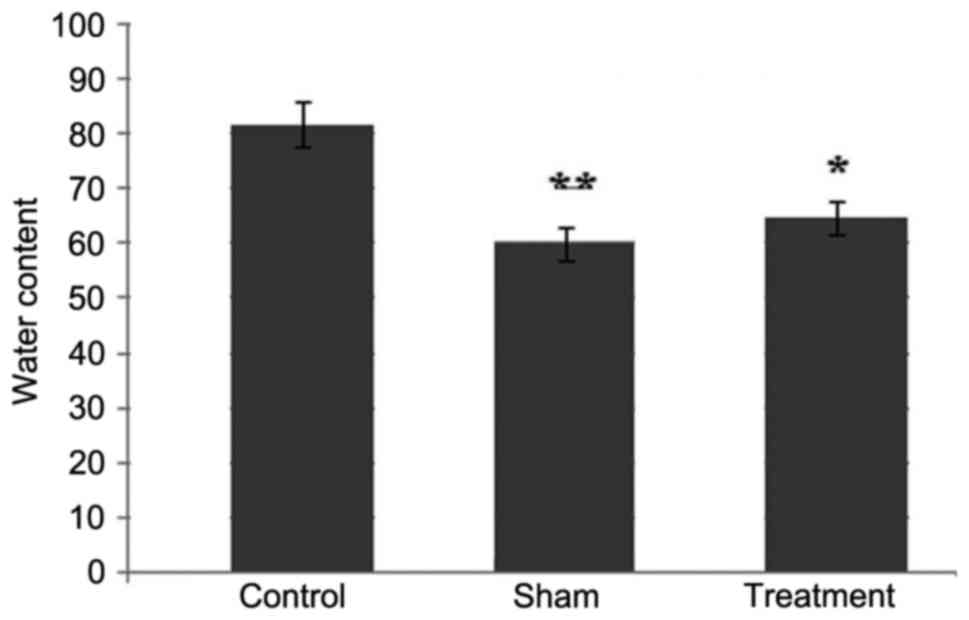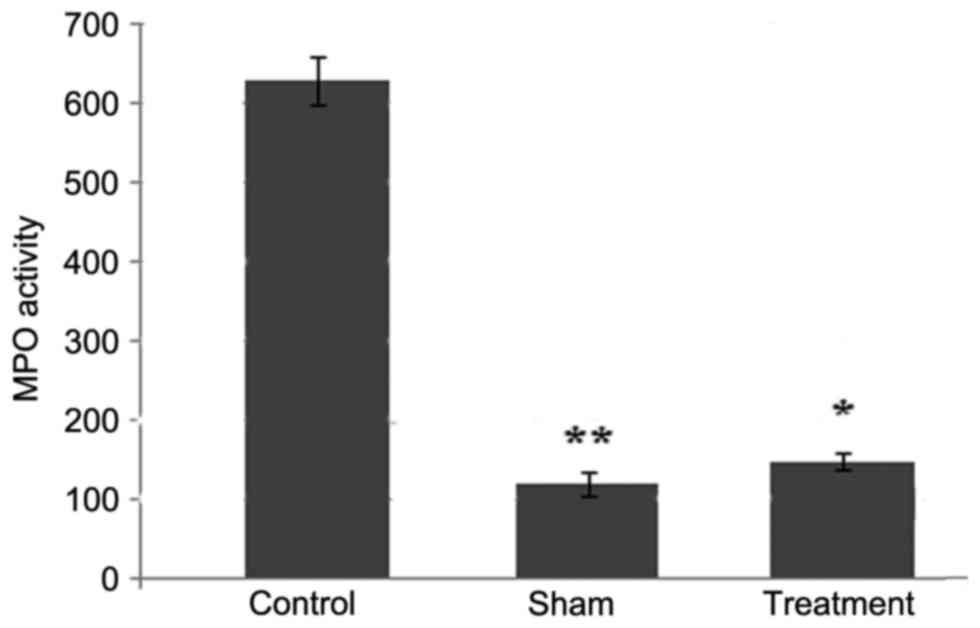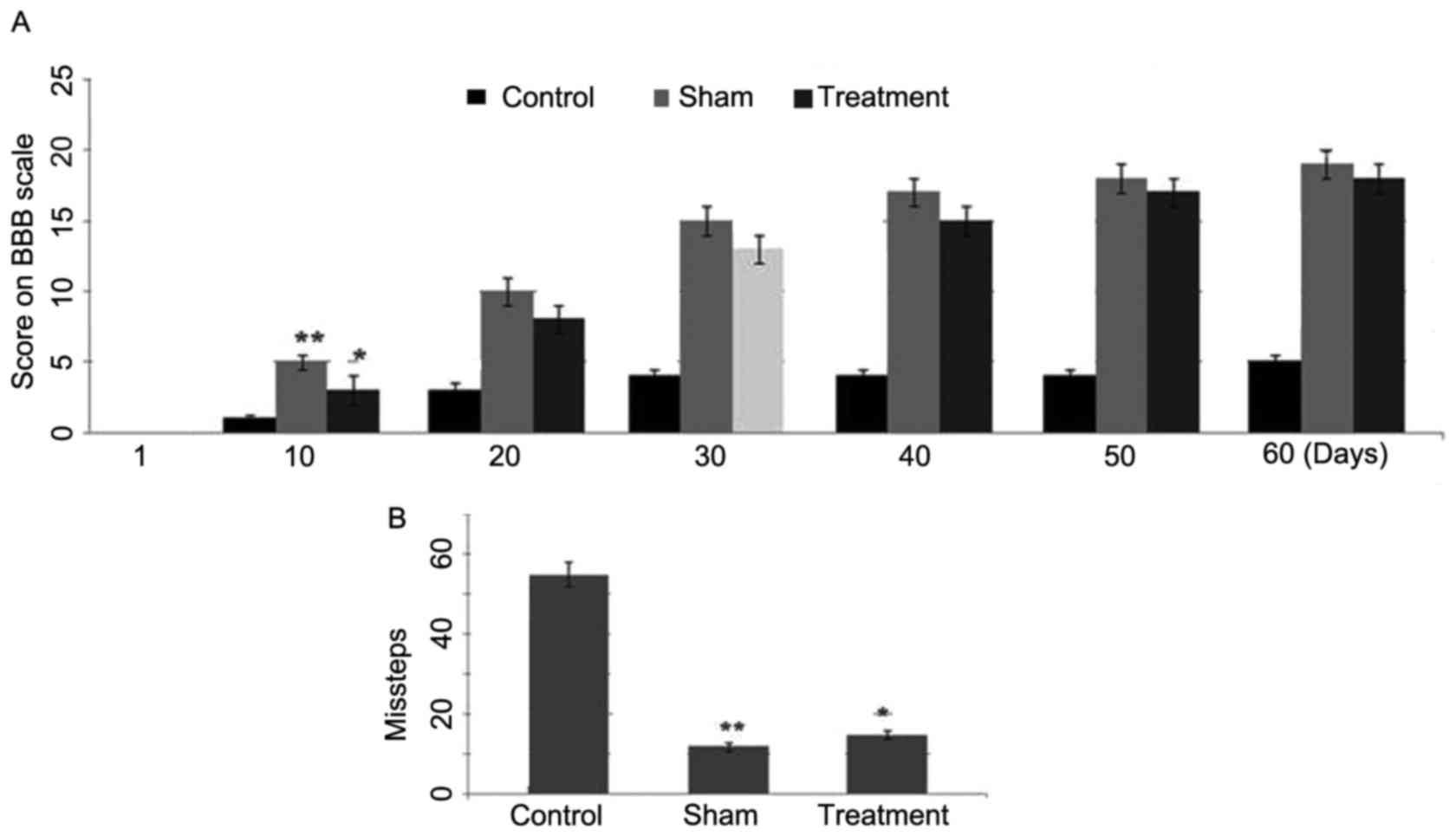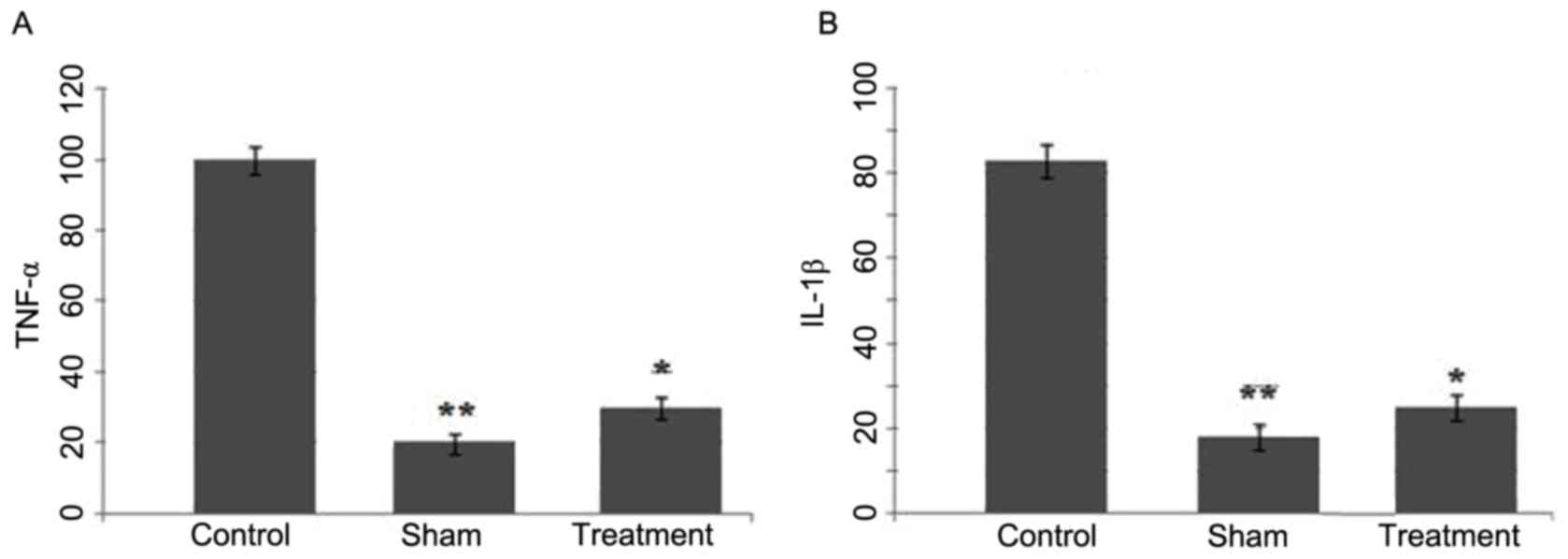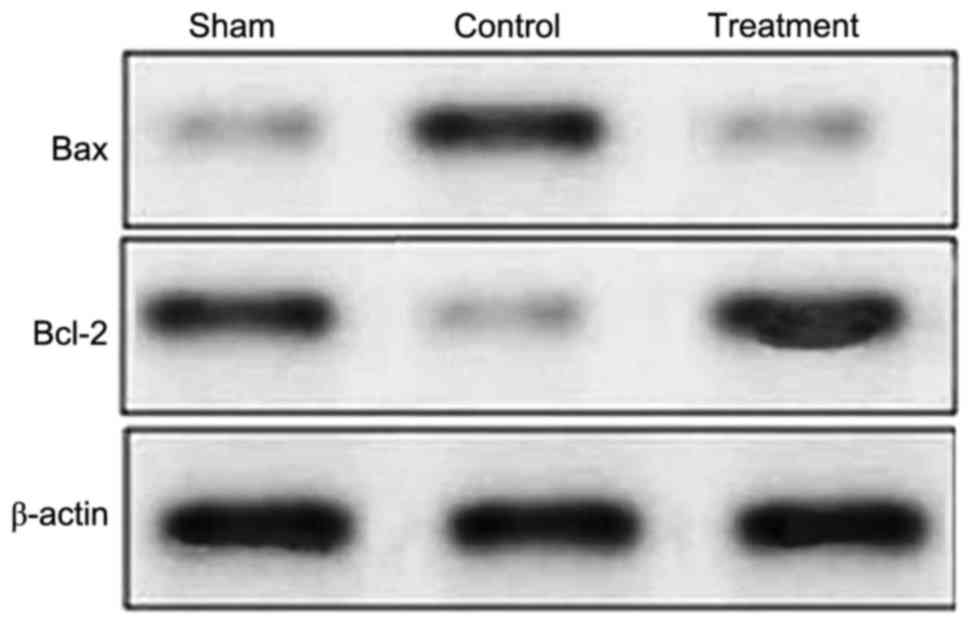Locomotor activity of rats with SCI is improved by dexmedetomidine by targeting the expression of inflammatory factors
- Authors:
- Published online on: April 26, 2018 https://doi.org/10.3892/mmr.2018.8930
- Pages: 415-420
Abstract
Introduction
Spinal cord injury (SCI) results from the breakdown of spinal cord tissues due to mechanical stress and is a severe health problem worldwide. The primary acute phase of SCI consists of direct tissue lesion and is accompanied by hemorrhage, whereas the secondary phase consists of neuronal apoptosis at the sites of lesion formation (1,2). During the secondary phase of SCI, the generation of reactive oxygen species, formation of edema, expression of cytokines leading to inflammation, and neuronal apoptosis occur (3–5). The onset of inflammation is considered to be the most serious factor resulting in secondary injury (3–5). Neuronal cells do not possess the ability to regenerate following SCI, which requires the treatment strategy be free from any harmful side effects. Therefore, studies have investigated the effect of inhibitors of apoptosis on neurological injuries, including SCI, with the aim of preventing the secondary phase of injury (6).
Cytokines, also known as inflammatory factors, including, tumor necrosis factor (TNF)-α), interleukin (IL)-6 and IL-18, are vital in various pathological and physiological process in cells. In patients with acute kidney injury, it has been observed that IL-18 acts as a marker for the level of acute kidney injury, and its expression determines patient survival rates (7). The expression of TNF-α and IL-6 mediated by IL-18 enhance the rate of inflammatory reactions leading to organ injury (8). Therefore, inhibiting the expression of inflammatory factors is important in the prevention of organ injury.
Dexmedetomidine is known for its role as a selective α-2 adrenoceptor agonist and it exhibits inhibitory effect on sympathetic activity (9,10). It has been reported that dexmedetomidine inhibits the apoptosis of neurons and protects various other organs from damage (11,12). Dexmedetomidine treatment has also been found to prevent liver and intestinal injury in patients following hepatectomy through the inhibition of cell apoptosis (13,14). In the present study, the effect of dexmedetomidine treatment on SCI in a rat model was investigated. It was observed that dexmedetomidine improved locomotor activity in the rats with SCI by inhibiting edema formation, reducing cytokine expression and inhibiting the induction of neuronal apoptosis.
Materials and methods
Experimental animals
A total of 30 adult male Sprague-Dawley rats (weight, 240–260 g) were obtained from the Experimental Animal Center (Xiamen University, Zhangzhou, China). The animals were housed in well-ventilated rooms with ~60% humidity, a temperature maintained at 23°C and a 12/12-h light/dark cycle for 15 days prior to the start of experiments. The experimental procedures were performed in accordance with the Guide for the Care and Use of Laboratory Animals of the National Institute of Health (15). The procedures were approved by the Government Animal Care Committee of the Medical College of Xiamen University under the reference no. 011/MCXU/2013. The animals were sacrificed following anesthetization with an injection of 400 mg/kg of chloral hydrate (Beyotime Institute of Biotechnology, Haimen, China) intraperitoneally. Following SCI, the animals were placed in their cages with free access to standard food and water.
Preparation of the traumatic SCI animal model using the weight-drop method
The SCI rat model was prepared using the weight-drop method. The rats were divided randomly into three groups of 10 rats: Sham injury, SCI and treatment groups. The rats were anesthetized with an injection of 400 mg/kg chloral hydrate and the spinal cord of each animal was exposed by T12 spinal laminectomy. Following exposure, an impactor with a diameter of 2.0 mm was used to perform the weight-drop injury to establish the traumatic SCI animal model. The animals in the sham group were not subjected to the weight-drop step.
Treatment strategy
Following SCI, the animals in the treatment group were injected with a single 50 mg/kg dose of dexmedetomidine (Sigma-Aldrich; Merck KGaA, Darmstadt, Germany) intraperitoneally immediately after the incision was closed. The animals in the sham and SCI groups received the same volume of normal saline.
Analysis of edema formation in the spinal cord of rats with SCI
The accumulation of water (edema formation) in the spinal cord tissues of the rats with SCI was determined by measuring the spinal cord weight. The wet weight of the spinal cord immediately following extraction was recorded. The spinal cord was then dried for 24 h at 75°C and the dry weight was measured. The difference in the wet and dry weight of the spinal cord was used for the determination of edema.
Determination of the activity of myeloperoxidase (MPO)
The activity of MPO was analyzed for the determination of neutrophil accumulation in the spinal cord tissues of the rats. Briefly, the spinal cord lysates were treated with the o-dianisidine, 50 mM potassium phosphate buffer and 20 mM H2O2 mixture. Absorbance of the solution was recorded spectrophotometrically at 460 nm to determine the rate of change. The quantity of enzymes (U/g) consumed to quench the reactive oxygen species was measured.
Behavioral assessments
Improvements in the locomotor activity of rats following dexmedetomidine treatment were analyzed using the method described by Basso et al (16). Three independent observers analyzed the locomotor activities of the rats using the Basso, Beattie and Bresnahan (BBB) locomotor rating scale. The scale is graded into 21 points with the lowest point indicating complete paralysis and the highest point representing normal locomotion. On day 1 post-SCI and every week following SCI, the rats were allowed to walk on an irregularly distributed horizontal wire grid. When walking, the observers carefully recorded the locomotor activity of the rats.
Determination of expression levels of TNF-α and IL-1β in rats
As the rate of inflammatory reactions resulting in organ injury is mediated by the increased expression of TNF-α and IL-6 (8), the present study analyzed the expression levels of TNF-α and IL-6. At 24 h post-SCI, the rats in the treatment groups were weighed, anesthetized, placed in a prone position and then sacrificed via injecting air through the ear vein. A small incision was made in the back of each rat, and the skin was carefully removed, followed by the subcutaneous tissues, to expose the spinal cord. The injured spinal cords were collected, placed into lysis buffer (5 mg/100 µl) and homogenized on ice. The commercially available TNF-α and IL-1β colorimetric kits (Calbiochem; EMD Millipore, Billerica, MA, USA) were used for determination of the expression levels of TNF-α and IL-1β expression according to the manufacturer's protocol. The determination was performed in triplicate.
Western blot analysis
At 24 h post-SCI, the rats were weighed, anesthetized, placed in a prone position and then sacrificed via injecting air through the ear vein. A small incision was made carefully in the back of rat, and the skin was removed, followed by subcutaneous tissues, to expose the spinal cord. The injured spinal cord was collected, placed into lysis buffer (5 mg/100 µl) and homogenized on ice. The homogenized spinal cord tissues were transferred into centrifuge tubes and lysed for 10 min, followed by centrifugation for 20 min at 4,000 × g at 4°C. The supernatants were decanted into the pre-cooled centrifuge tubes. The concentration of proteins was determined by Bicinchoninic Acid protein assay kit (Beijing Solarbio Science & Technology Co., Ltd., Beijing, China) according to the manufacturer instructions. A total of 2 µg protein samples were loaded onto 15% SDS-polyacrylamide gel and separated by electrophoresis. The separated proteins were then transferred onto nitrocellulose membranes. The membranes were blocked with 5% non-fat-milk solution and then blotted with appropriate primary antibodies against Bax (1:1,000; 5023S) and Bcl-2 (1:1,000; 15071S; both from Cell Signaling Technology, Inc., Danvers, MA, USA). The incubation with primary antibodies was performed overnight at 4°C followed by 1 h incubation with peroxidase-labeled secondary antibody (1:2,000 dilution; 7077S; Cell Signaling Technology, Inc.) at room temperature. The bands were visualized using an enhanced chemiluminescence detection technique (GE Healthcare Life Sciences, Chalfont, UK) using Quantity One Software v4.2 (Bio-Rad Laboratories, Inc., Hercules, CA, USA).
Immunohistochemical assay and H&E staining
After 10 days post-treatment with dexmedetomidine following SCI, two animals from each group were anesthetized using Nembutal. The thoracic cavities of the rats after opening were intracardially perfused using normal saline. Then, ~400 ml fixative containing paraformaldehyde (4%) in 0.1 M PBS (pH 7.4) was used for perfusion of the rats and subsequently T6-14 segment was extracted from the animal spinal cord. The spinal cord tissues were treated with phosphate-buffered sucrose (30%) following 3 h of fixing paraformaldehyde (4%) in 0.1 M PBS at room temperature. The paraffin embedded tissues were mounted on the slides coated with 0.02% poly-L-lysine. The chromagen used contained a combination of avidin-biotin-peroxidase complex (Invitrogen; Thermo Fisher Scientific, Inc.) and 3,3′-diaminobenzidine hydrochloride (DAB; Sigma-Aldrich; Merck KGaA). For this, the tissues following PBS washing were incubated for 45 min at room temperature with 1% bovine serum albumin (Gibco; Thermo Fisher Scientific, Inc.). The tissues were then incubated at 4°C for overnight with primary antibodies against platelet-derived growth factor subunit B (PDGF-B; dilution, 1:100; cat. no. 8912; Cell Signaling Technology, Inc.). Following incubation, tissues were washed with PBS and then incubated with biotinylated goat anti-rabbit secondary antibody (diluted to 1:200 in PBS) at room temperature for 1 h. Visualization was performed using DAB (0.05%) and hydrogen peroxide (0.3%) in combination. Dehydration of tissues using ethanol and xylene was followed by mounting under coverslips. For pathological changes 2 µm thick tissue sections were stained with hematoxylin for 5 min at 25°C and with eosin for 2 min at 25°C. Stained sections were imaged using a Olympus BX51 light microscope (Olympus Corporation, Tokyo, Japan) (magnification, ×400).
Statistical analysis
For statistical analysis, Statistical Package for Social Sciences (SPSS) version 13.0 for Windows (SPSS, Inc., Chicago, IL, USA) was used. One-way analysis of variance was used for the comparison of BBB scores. P<0.05 was considered to indicate a statistically significant difference. Data are expressed as the mean ± standard error of the mean.
Results
Dexmedetomidine prevents the formation of edema in rat spinal cord tissues following SCI
The examination of the rats 24 h following SCI showed the formation of edema due to the accumulation of water content in the spinal cord tissues. However, treatment of the rats with dexmedetomidine at a dose of 50 mg/kg significantly decreased the formation of edema in the tissues of the spinal cord (Fig. 1). Compared with the rats in the sham and dexmedetomidine treatment groups, edema formation was higher in the spinal cord of rats in the control group.
Dexmedetomidine inhibits the infiltration of neutrophils in the spinal cord tissues
At 24 h post-SCI, the accumulation of neutrophils was increased, which was evident by a significant increase in the activity of MPO. Treatment of the rats with dexmedetomidine at a dose of 50 mg/kg exhibited an inhibitory effect on the SCI-induced increase in the accumulation of neutrophils (Fig. 2). Compared with the animals in the control group, the accumulation of neutrophils was significantly (P<0.05) decreased in the dexmedetomidine and sham groups (Fig. 2).
Effect of dexmedetomidine on functional recovery following SCI in rats
The results from the BBB locomotor test revealed a significant (P<0.001) increase in locomotor performance 10 days following SCI in the dexmedetomidine treatment group (Fig. 3A). Compared with the first day following SCI, the BBB scores were significantly increased in the rats of the dexmedetomidine group 10 days post-SCI. The comparison of BBB locomotor scores showed the highest score in the sham group, followed by the dexmedetomidine group and then the control group. However, the scores were closer in the animals of the dexmedetomidine and sham groups (Fig. 3A). In the grid walking test, the animals in the control group showed a higher number of missteps, compared with those in the dexmedetomidine treatment group (Fig. 3B). Therefore, a significant improvement was observed in the locomotion performance of the animals with SCI treated with dexmedetomidine.
Effect of the dexmedetomidine on the expression levels of TNF-α and IL-1β following SCI
The expression levels of TNF-α and IL-1β in the spinal cord tissues of SCI rats treated with dexmedetomidine were analyzed using western blot analysis. SCI led to a marked increase in the expression of levels of TNF-α and IL-1β at 24 h (control group), compared with the sham group (Fig. 4A and B). However, in the rats treated with dexmedetomidine following SCI, no such increase in the expression levels of TNF-α or IL-1β were observed in the spinal cord tissues (Fig. 4).
Effect of dexmedetomidine on the protein expression levels of Bax and Bcl-2
Compared with the rats in the sham group, the rats in the control group revealed a marked increase in the expression of Bax following SCI (Fig. 5). Treatment with dexmedetomidine following SCI had an inhibitory effect on the expression of Bax in the tissues of the spinal cord. The expression of Bax in the dexmedetomidine treatment group was similar to that of the control group (Fig. 5). Compared with the sham group, the expression of Bcl-2 was significantly reduced in the rats 24 h following SCI, however, the expression of Bcl-2 was significantly increased in the rats with SCI treated with dexmedetomidine (Fig. 5).
Hematoxylin and eosin staining
The examination of spinal cord tissues using light microscopy revealed the presence of large cavities. The number of neuronal cells undergoing apoptosis and gliocytes increased markedly in the rats with SCI. However, treatment of the rats with dexmedetomidine prevented the formation of cavities, induction of neuronal cell apoptosis and increased number of gliocytes in the injured region (Fig. 6). The results from the immunohistochemical examination showed reductions in the percentage of PDGF-B-positive cells and porosis formation in the spinal cord of rats with SCI. Treatment of the SCI rats with dexmedetomidine increased the migration of PDGF-B-positive cells to the injured region of spinal cord and prevented porosis formation (Fig. 7).
Discussion
In the present study, the effect of dexmedetomidine on locomotor activity in the rats following SCI was investigated. The study demonstrated a significant improvement in the locomotor activity of rats with SCI treated with dexmedetomidine through the inhibition of edema formation, reduction in neutrophil accumulation, decrease in the expression of cytokines and inhibition of cell apoptosis.
Studies have demonstrated that SCI leads to the development of edema and production of reactive oxygen species, and inhibits the potential of neurons to undergo repair, which is associated with worsening of the disorder (17). These factors are responsible for mediating the onset of secondary processes in cases of SCI. In the present study, dexmedetomidine exhibited an inhibitory effect on the accumulation of neutrophils, which was evident by a significant decrease in the activity of MPO. Treatment of the rats suffering from SCI with dexmedetomidine led to a significant decrease in the expression of factors involved in inflammation, including TNF-α and IL-1β. Treatment of mice with SCI with certain chemotherapeutic agents has been shown enhance the regenerative potential of the affected neurons, prevent neuronal apoptosis and induce improvements in motor function (18,19). In the present study, the expression of Bax was reduced, whereas that of Bcl-2 was increased in the spinal cord tissues of SCI rats treated with dexmedetomidine. This suggested that dexmedetomidine inhibited the induction of neuronal apoptosis. Treatment of the SCI rats with dexmedetomidine also led to improvements in the functions of limbs in the rats.
SCI is followed by the development of inflammation and the subsequent accumulation of neutrophils into the tissues (20). Inflammatory factors are secreted and reactive oxygen species are produced, resulting in neuronal apoptosis and necrosis (21,22). Therefore, the inhibition of cytokine secretion by the spinal cord tissues following SCI can prevent neuronal cell damage. The results from the present study demonstrated a significant decrease in the expression of cytokines TNF-α and IL-1β in the rats with SCI treated with dexmedetomidine.
In conclusion, the results of the present study demonstrated that dexmedetomidine improved the locomotor function of rats with SCI through the inhibition of edema formation, reduction of neutrophil accumulation, inhibited expression of cytokines and inhibited induction of apoptosis. Therefore, dexmedetomidine may be used for the improvement of locomotor function in cases of SCI.
Acknowledgements
The authors are highly thankful to The First Affiliated Hospital of Shandong University of Traditional Chinese Medicine (Jinan, China) for the facilities to complete the research of the present study.
Funding
No funding was received.
Availability of data and materials
All data generated or analyzed during this study are included in this published article.
Authors' contributions
ZHJ and BX performed the experimental work, whereas ZWX made substantial contributions to the analysis of the obtained data. WGW and LW made substantial contributions to the conception and design of the study and wrote the paper. All authors read and approved the final manuscript.
Ethics approval and consent to participate
The experimental procedures were performed in accordance with Guide for the Care and Use of Laboratory Animals of the National Institute of Health (15). The procedures were approved by the Government Animal Care Committee of the Medical College of Xiamen University under the reference no. 011/MCXU/2013.
Consent for publication
Not applicable.
Competing interests
The authors declare that they have no competing interests.
References
|
Schmitt C, Miranpuri GS, Dhodda VK, Isaacson J, Vemuganti R and Resnick DK: Changes in spinal cord injury-induced gene expression in rat are strain-dependent. Spine J. 6:113–119. 2006. View Article : Google Scholar : PubMed/NCBI | |
|
Hong Z, Chen H, Hong H, Lin L and Wang Z: TSP-1 expression changes in diabetic rats with spinal cord injury. Neurol Res. 31:878–882. 2009. View Article : Google Scholar : PubMed/NCBI | |
|
Qiao F, Atkinson C, Kindy MS, Shunmugavel A, Morgan BP, Song H and Tomlinson S: The alternative and terminal pathways of complement mediate post-traumatic spinal cord inflammation and injury. Am J Pathol. 177:3061–3070. 2010. View Article : Google Scholar : PubMed/NCBI | |
|
Beattie MS: Inflammation and apoptosis: Linked therapeutic targets in spinal cord injury. Trends Mol Med. 10:580–583. 2004. View Article : Google Scholar : PubMed/NCBI | |
|
Beck KD, Nguyen HX, Galvan MD, Salazar DL, Woodruff TM and Anderson AJ: Quantitative analysis of cellular inflammation after traumatic spinal cord injury: Evidence for a multiphasic inflammatory response in the acute to chronic environment. Brain. 133:433–447. 2010. View Article : Google Scholar : PubMed/NCBI | |
|
Grasso G, Sfacteria A, Meli F, Fodale V, Buemi M and Iacopino DG: Neuroprotection by erythropoietin administration after experimental traumatic brain injury. Brain Res. 1182:99–105. 2007. View Article : Google Scholar : PubMed/NCBI | |
|
Nisula S, Yang R, Poukkanen M, Vaara ST, Kaukonen KM, Tallgren M, Haapio M, Tenhunen J, Korhonen AM and Pettilä V: FINNAKI Study Group: Predictive value of urine interleukin-18 in the evolution and outcome of acute kidney injury in critically ill adult patients. Br J Anaesth. 114:460–468. 2015. View Article : Google Scholar : PubMed/NCBI | |
|
Yang Y, Zhang ZX, Lian D, Haig A, Bhattacharjee RN and Jevnikar AM: IL-37 inhibits IL-18-induced tubular epithelial cell expression of pro-inflammatory cytokines and renal ischemia-reperfusion injury. Kidney Int. 87:396–408. 2015. View Article : Google Scholar : PubMed/NCBI | |
|
Miranda ML, Balarini MM and Bouskela E: Dexmedetomidine attenuates the microcirculatory derangements evoked by experimental sepsis. Anesthesiology. 122:619–630. 2015. View Article : Google Scholar : PubMed/NCBI | |
|
Geloen A, Chapelier K, Cividjian A, Dantony E, Rabilloud M, May CN and Quintin L: Clonidine and dexmedetomidine increase the pressor response to norepinephrine in experimental sepsis: A pilot study. Crit Care Med. 41:e431–e438. 2013. View Article : Google Scholar : PubMed/NCBI | |
|
Duan X, Li Y, Zhou C, Huang L and Dong Z: Dexmedetomidine provides neuroprotection: Impact on ketamine-induced neuroapoptosis in the developing rat brain. Acta Anaesthesiol Scand. 58:1121–1126. 2014. View Article : Google Scholar : PubMed/NCBI | |
|
Turan A, Bashour CA, You J, Kirkova Y, Kurz A, Sessler DI and Saager L: Dexmedetomidine sedation after cardiac surgery decreases atrial arrhythmias. J Clin Anesth. 26:634–642. 2014. View Article : Google Scholar : PubMed/NCBI | |
|
Wang ZX, Huang CY, Hua YP, Huang WQ, Deng LH and Liu KX: Dexmedetomidine reduces intestinal and hepatic injury after hepatectomy with inflow occlusion under general anaesthesia: A randomized controlled trial. Br J Anaesth. 112:1055–1064. 2014. View Article : Google Scholar : PubMed/NCBI | |
|
Si YN, Bao HG, Xu L, Wang XL, Shen Y, Wang JS and Yang XB: Dexmedetomidine protects against ischemia/reperfusion injury in rat kidney. Eur Rev Med Pharmacol Sci. 18:1843–1851. 2014.PubMed/NCBI | |
|
Guide for the Care and Use of Laboratory Animals: National Research Council (US) Committee for the Update of the Guide for the Care and Use of Laboratory Animals. 8th edition. National Academies Press; Washington (DC): 2011 | |
|
Basso DM, Beattie MS and Bresnahan JC: Graded histological and locomotor outcomes after spinal cord contusion using the NYU weight-drop device versus transection. Exp Neurol. 139:244–256. 1996. View Article : Google Scholar : PubMed/NCBI | |
|
Loane DJ and Byrnes KR: Role of microglia in neurotrauma. Neurotherapeutics. 7:366–377. 2010. View Article : Google Scholar : PubMed/NCBI | |
|
Yin Y, Sun W, Li Z, Zhang B, Cui H, Deng L, Xie P, Xiang J and Zou J: Effects of combining methylprednisolone with rolipram on functional recovery in adult rats following spinal cord injury. Neurochem Int. 62:903–912. 2013. View Article : Google Scholar : PubMed/NCBI | |
|
Genovese T, Mazzon E, Crisafulli C, Esposito E, Di Paola R, Muià C, Di Bella P, Meli R, Bramanti P and Cuzzocrea S: Combination of dexamethasone and etanercept reduces secondary damage in experimental spinal cord trauma. Neuroscience. 150:168–181. 2007. View Article : Google Scholar : PubMed/NCBI | |
|
McTigue DM, Tani M, Krivacic K, Chernosky A, Kelner GS, Maciejewski D, Maki R, Ransohoff RM and Stokes BT: Selective chemokine mRNA accumulation in the rat spinal cord after contusion injury. J Neurosci Res. 53:368–376. 1998. View Article : Google Scholar : PubMed/NCBI | |
|
Zhao W, Xie W, Le W, Beers DR, He Y, Henkel JS, Simpson EP, Yen AA, Xiao Q and Appel SH: Activated microglia initiate motor neuron injury by a nitric oxide and glutamate-mediated mechanism. J Neuropathol Exp Neurol. 63:964–977. 2004. View Article : Google Scholar : PubMed/NCBI | |
|
Morino T, Ogata T, Horiuchi H, Takeba J, Okumura H, Miyazaki T and Yamamoto H: Delayed neuronal damage related to microglia proliferation after mild spinal cord compression injury. Neurosci Res. 46:309–318. 2003. View Article : Google Scholar : PubMed/NCBI |



